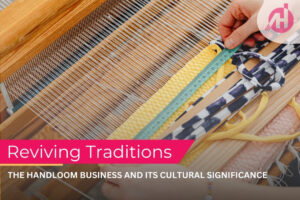Handloom weaving is one of the oldest and most revered textile crafts in the world. It represents not just an ancient technique of fabric production but also a rich cultural heritage that continues to evolve and thrive. This blog delves into the evolution of handloom weaving, its significance across cultures, and its relevance in today’s world.
The Origins of Handloom Weaving
Handloom weaving has a history that stretches back thousands of years. The earliest evidence of handwoven textiles dates to the ancient civilizations of Egypt, Mesopotamia, and the Indus Valley. These early weavers used simple tools to create intricate patterns and fabrics, setting the foundation for what would become a global craft.
In India, handloom weaving has been practiced since the time of the Vedic period. The art of weaving was highly developed, with distinct regional styles and techniques emerging over centuries. From the intricate brocades of Varanasi to the colorful ikats of Odisha, India’s handloom tradition is a testament to the country’s rich cultural diversity.
Handloom Weaving Through the Ages
The evolution of handloom weaving is marked by both technological advancements and cultural shifts. In ancient times, handlooms were simple wooden frames operated manually by skilled artisans. These looms were later refined with the introduction of treadle looms during the medieval period, which allowed for more complex patterns and greater efficiency.
The Industrial Revolution in the 18th century brought significant changes to textile production. Mechanized looms began to dominate the industry, leading to the decline of handloom weaving in many parts of the world. However, this period also saw a revival of interest in traditional crafts as a reaction against the uniformity of industrial textiles.
In the 20th century, handloom weaving experienced a renaissance. The Arts and Crafts Movement, which began in Britain, emphasized the value of handmade goods and the importance of preserving traditional skills. This movement spread globally, inspiring renewed appreciation for handwoven textiles.
The Significance of Handloom Weaving
Handloom weaving is not merely a method of fabric production; it holds deep cultural and economic significance. Here’s why handloom weaving continues to be important:
- Cultural Heritage: Handloom textiles carry the essence of cultural traditions and craftsmanship. Each region has its unique weaving techniques and patterns, reflecting local history, beliefs, and aesthetics. For instance, the vibrant Bandhani of Gujarat and the elegant Kanchipuram silks of Tamil Nadu each tell a story of their respective cultures.
- Economic Impact: Handloom weaving supports millions of artisans worldwide, particularly in developing countries. It provides livelihoods for rural communities, often empowering women and contributing to local economies. Handloom industries also help preserve traditional skills and provide an alternative to mechanized production.
- Sustainability: Handloom weaving is an environmentally friendly process. Unlike industrial textile production, it requires minimal energy and often uses natural, biodegradable materials. The slow fashion movement, which emphasizes quality over quantity, aligns perfectly with the principles of handloom weaving.
- Artistic Expression: Handwoven fabrics are prized for their artistic qualities. The intricate patterns, textures, and colors that artisans create are often unique and cannot be replicated by machines. This artistic value adds a layer of individuality and charm to handloom products.
The Modern Revival of Handloom
In recent years, there has been a significant resurgence of interest in handloom weaving. This revival is driven by several factors:
- Consumer Awareness: Today’s consumers are more conscious of the origins and impacts of their purchases. Handloom fabrics, with their heritage and ethical production processes, appeal to those seeking sustainable and socially responsible choices.
- Technological Integration: Modern technology has helped revitalize handloom weaving. Innovations in design software and loom technology have allowed artisans to experiment with new patterns and techniques while preserving traditional methods.
- Global Market Access: The internet and social media have provided artisans with platforms to showcase their work to a global audience. This exposure has helped increase demand for handwoven textiles and connect artisans with buyers worldwide.
- Supportive Policies: Many governments and organizations are now recognizing the value of handloom weaving and are implementing policies to support and promote the industry. These include grants, training programs, and marketing initiatives aimed at preserving and expanding handloom traditions.
The Future of Handloom Weaving
The future of handloom weaving is bright, with ongoing efforts to blend tradition with innovation. As we continue to navigate a world of rapid industrialization and environmental concerns, handloom weaving stands out as a beacon of cultural preservation and sustainable craftsmanship. By supporting handloom products, consumers contribute to the survival of this ancient art and help ensure that future generations can continue to enjoy and appreciate its beauty and significance.
Conclusion
Handloom weaving is a testament to the enduring power of human creativity and tradition. Its evolution over the centuries highlights the resilience of a craft that has adapted to changing times while remaining true to its roots. As we move forward, the significance of handloom weaving remains as profound as ever, symbolizing a harmonious blend of heritage, artistry, and sustainability. Embracing handloom textiles means honoring the past, supporting the present, and investing in a future where craftsmanship and cultural values continue to thrive.






